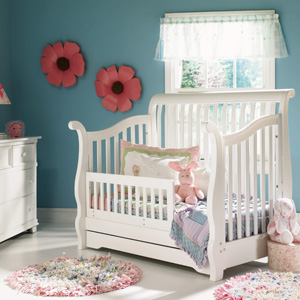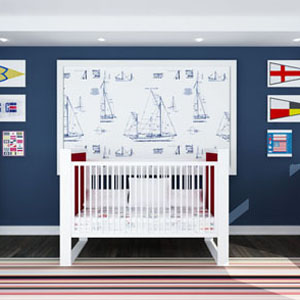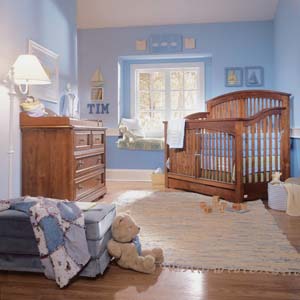 |

Choose new cribs over hand-me-downs that may not comply with current safety standards. Photo: Stanley Furniture

Your baby will spend more time sleeping than just about anything else, so whatever you choose in the way of bedding and furniture, you want to make sure it’s a safe, secure environment. Photo: ducduc

When you’re shopping for a dresser or chest, look for anti-tipping mechanisms, ask the retailer if the piece passed the ASTM tipping standard, or check the manufacturer’s website. Photo: Stanley Furniture
When you’re shopping for a dresser or chest, look for anti-tipping mechanisms, ask the retailer if the piece passed the ASTM tipping standard, or check the manufacturer’s website. Photo: Stanley Furniture
Hunt for Safety Hazards
A great way to evaluate a nursery’s potential safety hazards is to get on your hands and knees on the floor and look at the room from baby’s vantage point.
-
Sleep Like a Baby
An inside look at how to design a nursery that’s as safe as it is beautiful.
- by Jane Kitchen
Let’s face it: designing a nursery is fun. Choosing a crib, picking out adorable bedding, getting everything set up just so—it’s incredibly satisfying. But while you may be focusing on creating the nursery of your dreams, keeping your baby safe and sound is your number one priority.
Look for “JPMA”
One of the most important ways to help you choose the safest baby products for your nursery is to look for the “JPMA Certified” seal. The JPMA (Juvenile Products Manufacturers Association) has certified more than 2,000 products in 17 different categories; if an item is JPMA-certified, that means all products made by that manufacturer meet or exceed the requirements of the current safety standard—which means peace of mind for you.
Start with the Crib
Your baby will spend more time sleeping than just about anything else, so whatever you choose in the way of bedding and furniture, you want to make sure it’s a safe, secure environment.
“Don’t underestimate the importance of building your nursery around where they sleep,” suggests Ali Wing, owner of New York-based retailer Giggle. “You’ll get the highest return for hours used.”
When shopping for a crib, make sure it meets current safety standards, and again, look for that JPMA Certified seal. Even if you are on a tight budget, you should never purchase a used crib at a garage sale or accept a hand-me-down if it does not meet current safety standards.
Crib slats or spindles should be spaced no more than 2 3/8 inches apart to keep baby’s head or other body parts from getting caught, and avoid cut-out areas on the headboard or footboard for the same reason. Never use a crib with corner posts over 1/16 of an inch above the end panels (unless they’re over 16 inches high for a canopy), because babies can strangle if their clothes become caught on corner posts. Never purchase a crib that has cracked or peeling paint, or rough edges or splinters. And be wary of used or hand-me-down cribs that may not comply with current safety standards.
Look For Quality
When you shop for your nursery furniture, find a store you can trust—one with staff who are informed and educated about the products they carry, suggests Richard Goore, director of marketing at Sacramento baby and kids store Goore’s.
“You want to make sure you’re purchasing quality; that quality typically will equate to safety,” says Goore.
To check for quality, run your hands across the furniture, advises Glenn Prillaman, executive vice president of marketing and sales for Stanley Furniture. Look out for sharp corners, and check for exposed staples or screws underneath pieces.
Once you’ve chosen your crib, choose where you will put it in your nursery before you decide where to place anything else. You’ll want to avoid placing it near windows, draperies, blinds, or wall-mounted decorative accessories with long cords—all of which pose strangulation hazards.
Choose a firm mattress and a crib sheet that fits tightly around the mattress corners. Any space between the mattress and crib side should be no more than the width of two fingers—anything wider is a potential space for baby to become entrapped.
Decorate Decisively
Think carefully about how to decorate the wall space over the crib, advises celebrity nursery designer Shalena Smith. You don’t want to use anything heavy that could fall on your baby, or anything with strings that she could pull down. Smith suggests opting for a mural or stencil with baby’s name, a soothing phrase or short nursery rhyme. Another option Smith uses often: a sky mural on the ceiling, which is soothing for baby when she is lying on her back and also minimizes the need for wall décor.
As you choose how to decorate the rest of your nursery, think about real-world applications.
“People tend to spend a lot of time decorating before the baby is born, and they tend to think about the newborn,” says Wing. “It’s so different six months later, when you have a baby who can sit up.”
Wing advises that you try to think through the basic stages your baby will go through in his or her first year from a safety standpoint.
As you decorate, don’t just think about how things look, think about how your baby will interact with them as she grows. Ask yourself, what can your baby reach from the crib once she starts being able to pull herself up? If she’s standing in the crib and shaking it (as babies do, when they get bigger), what could be knocked down?
When you’re shopping for a dresser or chest, look for anti-tipping mechanisms, ask the retailer if the piece passed the ASTM tipping standard, or check the manufacturer’s website, suggests Prillaman. Before the year is out, your baby may be looking at those drawers as a series of fun steps to climb up and you want to make sure she doesn’t pull the whole thing over on herself.
Smith says when she finishes a nursery design, she gets down on her hands and knees and crawls on the floor so she can see the room from baby’s perspective—what’s hazardous, what’s in the way, what she can’t see from an adult standing position. Outlets, cords, electrical wires, houseplants, trashcans, floor lamps and unstable furniture that baby can pull over all pose risks once your baby is mobile.
“There’s an amazing romance of designing a dream nursery, but before you know it, you have a moving child,” says Wing. “If you can put that lens on…it will pay you back, in safety, in budget and in peace of mind.”

